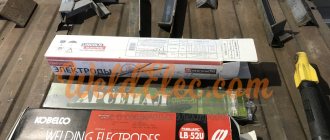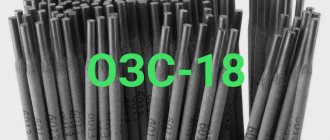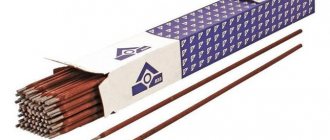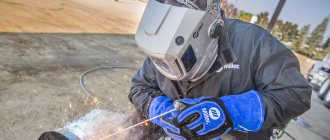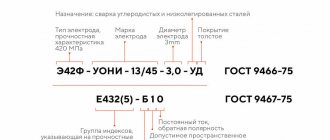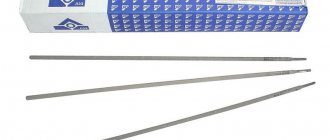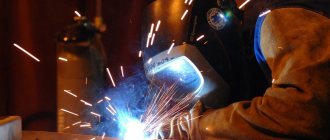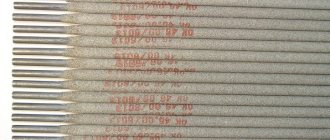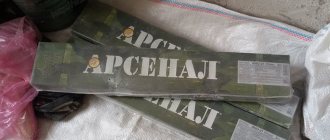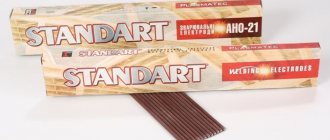Beginning welders often encounter large amounts of slag when welding metals. For example, due to a lack of experience, during welding with an inverter, the slag begins to go ahead of the arc, leaks into the weld pool, and solidifies in it. Because of this, the welding seam looks unsightly, it seems to be “loose”, large pores and other defects are visible on it.
How to cook without slag and beautiful seams? This is probably the very first question for novice welders. Everyone wants to weld seams like those in the “picture,” forgetting that skill comes with experience. In this article, I would like to share with the reader information about why many slag inclusions occur during welding, and how to get rid of them - once and for all.
Basic electrode coating - characteristics
Any electrode coating is a mixture of crushed components and a binder. The powder mixture is applied to a metal rod and serves to protect against various external factors.
The main coating is designated by the letter "B" . This mixture is produced from calcium and magnesium carbonates. These include elements such as marble, magnesite, dolomite. Fluorspar (CaF2) is also added to the listed minerals as a slag diluent. calcium fluoride coated electrodes .
Characteristics:
- The gas-protective environment that is formed during the welding process consists almost entirely of CO and CO2.
- The low hydrogen content allows the formation of strong seams without the risk of cracks .
- Low content of oxygen and various impurities (for example, sulfur and phosphorus) in the weld metal.
- In most cases, work should be carried out on direct current . The presence of plastic spar in the coating composition impairs the performance of alternating current electrodes. Therefore, most often a direct current of reverse polarity is needed.
Classification of electrodes according to GOST 9466-75
Coated metal electrodes intended for manual arc welding are divided into groups according to several parameters: purpose, chemical composition and mechanical properties, thickness and type of coating applied. In addition, welding and technological indicators are also taken into account.
Types of electrodes by purpose
Depending on the scope of use, the products are intended:
- for working with carbon or low-carbon materials, the degree of tensile strength of which does not exceed 600 MPa. They are marked with the letter “U”;
- for joining workpieces made of structural alloy steel, the tensile strength of which does not exceed 600 MPa. Electrodes are marked with the letter “L”;
- for welding alloy steel, resistant to high temperatures. Products are designated by the letter “T”;
- for welding high-alloy steel with special characteristics. The visual marker is the letter “B”;
- to create a deposited layer on the surface of materials with special properties. The electrodes are designated with the letter “H”.
The listed standards divide electrodes into types depending on the chemical composition of the deposited metal and in accordance with the mechanical characteristics of the material being processed. The marking contains numbers indicating the minimum tensile strength in kgf/mm2: E42, E42A, E50 and others. The letter after the digital marker indicates high plastic characteristics, good viscosity and limitations on chemical components.
By coating thickness
This indicator provides for the division of products taking into account the D/d ratio, where D corresponds to the diameter of the coating, and d to the circumference of the metal rod. It is customary to distinguish electrodes by coating thickness:
- thin . The diameter ratio is less than 1.2. Marked with the letter “M”;
- average . The result is in the range 1.2 < x < 4.5. Indicated by the letter “C”;
- thick _ The coefficient is less than 1.8, but more than 1.45. Marker - “D”;
- especially thick . The number obtained by dividing the two diameters is above 1.8. The “G” marking is a distinctive feature of the product.
According to the provisions of GOST 9466 - 75, it is divided into three groups that differ in quality. It is determined by the condition of the coating, the precision of the coating and the rod, the content of phosphorus and sulfur in the deposit.
Types of electrode coating
The values are shown in the table below:
| Coverage type | Designation according to GOST 9466-75 | International ISO designation |
| Sour | A | A |
| Basics | B | B |
| Rutile | R | R |
| Pulp | C | C |
| Mixed coatings | ||
| Acid-rutile | AR | AR |
| Rutile-basic | RB | R.B. |
| Rutile-cellulose | RC | R.C. |
| Other (mixed) | P | S |
| Rutile with iron powder | RJ | R.R. |
According to the spatial location of the float
Electrodes should be selected depending on the spatial location of the joint:
- recommended for work in any position - designated “1”;
- the location of the weld in any position except the top-down direction is allowed - “2”;
- for the following spatial arrangement: vertical, horizontal, bottom and vertical from bottom to top - “3”;
- for working in the lower position, including the boat method - “4”.
By type and polarity of current
All values are collected in table form:
| Recommended DC Polarity | Open circuit voltage of AC source, V | Designation | |
| Rated voltage | Maximum deviation | ||
| Reverse | — | — | 0 |
| Any | 50 | ±5 | 1 |
| Straight | 2 | ||
| Reverse | 3 | ||
| Any | 70 | ±10 | 4 |
| Straight | 5 | ||
| Reverse | 6 | ||
| Any | 90 | ±5 | 7 |
| Straight | 8 | ||
| Reverse | 9 | ||
Application
Basic coated electrodes are excellent for use in the following applications:
- welding of mild steels with high sulfur content;
- steels with a high content of sulfur, carbon, phosphorus;
- welding of hardening steels, in which cold cracks can form;
- when welding low-alloy and high-alloy steels, which are used under heavy loads and high temperatures;
- if you need to weld parts of large thickness;
- when welding rigid structures.
Meaning of marking
The designation of electrodes on the packaging is standardized for all manufacturers.
There are many indicators, so you need to understand at least the main ones:
- The first to enter is the type of rod. The letter E means intended for manual welding using an arc, A means the plasticity of the seam, and the number means the limit of mechanical strength.
- Next, the brand of the electrode is printed. This name is prescribed by GOST or patented by the manufacturer independently.
- The diameter of the rod is indicated in mm.
- The purpose is marked with capital letters U, L, T, V, N.
- Thickness of the coating (coating) - thick D, thin M, medium C, maximum G.
- The group index includes indicators of the weld’s resistance to corrosion, its heat resistance, maximum operating temperature and other characteristics for specialists
- The chemical composition is indicated by letters based on the name of the main element and their combinations.
- The position in which you need to work with the electrode has 3 options. Vertical is indicated by number 2, universal - 1, horizontal in the vertical plane - 3, for welding lower corners - 4. This is an international marking standard.
We recommend reading Calculation of electrode consumption during welding
Advantages and disadvantages
When comparing the basic coating of electrodes with other types, both advantages and disadvantages of this type can be identified.
The benefits include:
- High ductility and toughness.
- Low content of gases and various impurities in the weld metal.
- Resistant to hot cracking.
- High resistance to hydrogen sulfide cracking. Ideal for welding pipelines carrying hydrogen sulfide compounds.
- Reliably weld critical structures.
- It is convenient to make seams of any spatial position .
- Low oxidizing capacity. The process of deoxidation and alloying of metal is improved.
The disadvantages include:
- Increased sensitivity to moisture. Electrodes with such a coating should be stored in a dry place.
- The welding arc may burn unstable if alternating current is used.
- Lengthening the arc during welding often leads to the appearance of pores in the weld.
- If the coating is moistened, the hydrogen content in the deposited metal increases. This can also lead to the formation of pores.
- It is necessary to calcinate the electrodes immediately before welding , since the optimal level of coating humidity should be 0.3%.
- If there is rust on the surface of the structures being welded, this also often causes pores to appear in the seam.
[ads-pc-2][ads-mob-2]
Features of DC welding
The welding process using constant voltage has a number of distinctive properties. Some characteristics can be considered as advantages, others as disadvantages.
Pros:
- the almost complete absence spattering ensures a reduction in electrode costs;
- the constant makes the welder’s work easier ;
- high productivity and labor efficiency;
- stability and stability of the arc even when exposed to negative influences: gusts of wind, voltage fluctuations and others;
- high-quality and neat seam;
- thin products ;
- absence of uncooked areas.
Minuses:
- welding using direct current is carried out using inverter machines. This equipment is highly expensive ;
- “magnetic blast” creates problems with an unstable arc in difficult places (eg corners).
Forward or reverse polarity
A welder needs to know! Connecting metals with direct current can be carried out in two modes: with direct and reverse polarity. First mode: a minus is connected to the electrode, and a plus to the metal product. When welding, reverse polarity is the opposite: positive to the electrode , negative to the workpiece.
Welding with direct polarity forms a cathode spot at the tip of the electrode, and reverse polarity creates an anodic spot. In the area of the anode spot the temperature reaches 3900°C, in the area of the cathode spot – up to 3200°C. During reverse polarity welding, heat is concentrated on the workpiece , causing the root of the weld to deepen .
Therefore, it is better to use reverse polarity voltage when welding thick-walled products and in cases where high temperatures are required .
Direct polarity current is used to work with the following materials:
- structures made of thin sheet steel;
- fusible metals;
- overheat-sensitive steels : stainless, alloyed and high-carbon.
Features of welding with reverse polarity:
- large spattering and high penetration are due to the fact that the metal from the materials is transferred into the weld pool in large drops;
- the electric arc is unstable ;
- correct heating of the product;
- some welding consumables show an increase in deposition rate ;
- the weld seam has a non-standard material composition : no carbon, a large amount of silicon and manganese.
- less heating of the rod allows the specialist to use currents with a higher value .
Features of connection with reverse polarity:
- the need to reduce the current potential to reduce the temperature of the product;
- It is recommended to weld with intermittent seam;
- very thin parts are welded with periodic interruption of the arc;
Flanging (see features of welding thin metal) - When joining with an overlap, the workpieces must be pressed tightly against each other. Failure to comply with this condition may result in burning of the upper part.
- the butt connection should be made with a minimum gap or, best of all, no gap at all;
- When welding thin products with uneven edges, a copper or steel plate should be placed under the joint . Such an auxiliary layer will take away some of the heat from the welding process;
- it is possible to flange the edges to be joined, the angle is 90°.
Useful video
Watch the video, which clearly explains the difference in the use of polarities.
[ads-pc-2][ads-mob-2]
The best electrodes with basic coating: brands
Kobelco LB-52U
They are produced at a subsidiary of the largest Japanese metallurgical concern Kobe Steel. Designed for welding critical structures made of steels with low carbon content. Widely used in cases where it is impossible to implement double-sided welding. Excellent for welding pipelines.
After welding with these electrodes, a minimal amount of residual slag remains.
The seam is uniform, has high ductility, there are no cracks or gaps. Learn more about LB-52U. IMPORTANT! The electrodes are highly sensitive to moisture. Before use, they must be calcined at temperatures up to 300°C. Otherwise, the electrode may burn poorly, and, accordingly, the quality of the seam will noticeably decrease.
OZL-8
Used when working with types of steel containing chromium and nickel. Provides a strong seam that is resistant to corrosion. Ideal for welding highly loaded components. When cooled, the seam retains its strength and does not crack. However, sudden cooling of the weld should not be allowed, as this promotes rapid crystallization and the formation of cracks.
Among the advantages of this brand:
- affordable price (compared to other electrodes of this class);
- ease of stitching.
SSSI 13/55
One of the best for welding critical structures. Best suited for working with carbon steel. Advantages:
- A special coating material, which when molten resembles resin, eliminates the possibility of the formation of slag ulcers . All slag is effectively removed from the seam.
- High strength seam , resistant to alternating loads.
FEATURES : The use of UUSI electrodes requires the welder to have some experience. Due to the nature of the coating, they are difficult to light. With a short break in work, the molten coating instantly “seizes” at the tip, so the electrode will have to be cleaned.
ESAB OK 61.30
Manufactured in Sweden (learn more about the manufacturer and its electrodes). Ideal for welding the following grades of stainless steel:
- 304L;
- 308L;
- 03X18H9;
- 06X18H11.
[ads-pc-4][ads-mob-4]
Which welding electrodes are best to buy?
The correct choice of rod depends on the technical characteristics of the tool, the physical characteristics of the metal and the type of welding.
Electrodes are divided into two groups:
- Melting;
- Non-melting.
The former are made from welding wire and are suitable for processing non-ferrous metals of small and medium thickness, as well as steels and alloys.
The basis for non-consumable electrodes is tungsten, graphite or carbon. Such rods are used in argon arc welding and processing of aluminum, copper, magnesium, bronze, and titanium. Often, when working with non-consumable electrodes, not only argon or helium, but also nitrogen or hydrogen are used.
An important selection criterion is also the diameter of the electrode. The permissible thickness of the metal being processed depends on it.
For small household needs, rods with a diameter of up to 2.5 mm will be sufficient, allowing welding of elements with a thickness of about 4 millimeters.
In turn, the required electrode diameter and maximum metal thickness are affected by the current strength of the welding tool.
Devices for professional use have a value of this characteristic of at least 200 A. This is enough for high-quality welding of metal with a thickness of more than 15 mm with an electrode with a diameter of 5 mm.
Advice! Despite their unlimited shelf life, welding electrodes are extremely demanding on storage conditions. It is important to prevent mechanical damage, contamination and high levels of humidity in the areas where the rods are kept. GOST 9466-75 provides for a storage temperature of electrodes not lower than +15°C.
Recommendations: 11 best semi-automatic welding machines
15 best welding inverters
8 best welding transformers
Welding with electrodes with basic coating
When using electrodes with a basic coating for welding, several nuances need to be taken into account:
- Do not extend the welding arc. In this case, the metal is saturated with nitrogen, which significantly reduces the strength of the weld. May cause cracks.
- The working surface must be completely dry. Otherwise, pores may form in the seam.
- Mandatory requirements for storing electrodes must be observed. Store only in a dry place at a temperature not lower than 15°C. Some manufacturers pack electrodes in vacuum packaging. This significantly extends their shelf life without the need for re-calcination.
Recommendations for novice welders
In order to become a professional welder, as well as to carry out auxiliary welding work at home, it is not enough just to know which electrodes to choose for beginners. You also need to have a general understanding of this area and the following rules in force:
- It is necessary to start mastering welding work with rutile electrodes. They do not emit harmful gases during operation, are ideally easy to ignite, function well with an arc of medium intensity and provide the opportunity to easily control and observe the weld pool.
- Correctly set the electrical parameters of the device - first of all, the polarity and current value. For example, with direct current and straight polarity, the workpiece should be connected to the positive terminal, the electrode to the negative. With reverse polarity, the opposite is true. The current strength must comply with the manufacturer's requirements.
Setting up a welding inverter Source ytimg.com
- Before starting the main work, you need to spend time and get your hands on training on unnecessary pieces of metal similar in type to the workpiece.
- The best way to improve the quality of work is to regularly improve your experience with various consumables and materials, take professional courses, etc.
Advice! Electric welding activities pose a potential threat to both the welder himself and others. Therefore, they must be carried out in compliance with safety precautions and in protective clothing.
